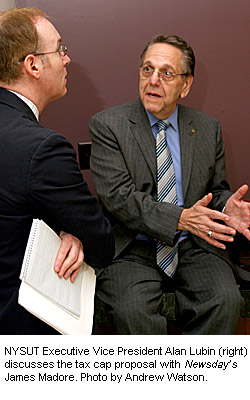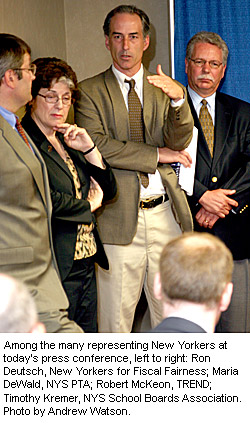ALBANY, N.Y. June 10, 2008 - A broad-based coalition representing more than one million New Yorkers today criticized legislation that would allow Albany - under a proposed property tax cap - to take away the voice of voters; impose artificial limits on local school spending; and abandon its promise to ensure equity in the education funding formula.
 The coalition acknowledged the need for property tax relief, but said an artificial cap - like the one endorsed by Gov. David Paterson - would harm education programs while dooming efforts to close the achievement gap. It said similar caps have failed in Massachusetts and other states because they do not address rising costs beyond the control of school districts, inevitably leading to cuts to education programs that serve children and other public services.
The coalition acknowledged the need for property tax relief, but said an artificial cap - like the one endorsed by Gov. David Paterson - would harm education programs while dooming efforts to close the achievement gap. It said similar caps have failed in Massachusetts and other states because they do not address rising costs beyond the control of school districts, inevitably leading to cuts to education programs that serve children and other public services.
The coalition is led by New Yorkers for Fiscal Fairness and the Educational Conference Board and includes such groups as the New York State Parent Teachers Association; the Working Families Party; Fiscal Policy Institute; New York State Council of Superintendents; New York State School Boards Association; New York State United Teachers; Civil Service Employees Association; Citizens Action of NY; TREND; Center on Budget and Policy Priorities; New York Association of School Business Officials; School Administrators Association of New York State; Campaign for Fiscal Equity and the Alliance for Quality Education.
"I am troubled by the fact that Governor Paterson is taking this preliminary report from the Commission on Property Tax Relief and immediately asking the Legislature to act on one facet of it," said Ron Deutsch, executive director of New Yorkers for Fiscal Fairness. "There are so many potential problems with his proposed tax cap that to try and rush it through now without careful consideration would be careless and a disservice to the taxpayers of New York state."
 "The proposed tax cap merely perpetuates an unequal system that already puts too much of a burden on the average working person," added ECB Chair Edward McCormick. "It's simplistic, arbitrary and unfair."
"The proposed tax cap merely perpetuates an unequal system that already puts too much of a burden on the average working person," added ECB Chair Edward McCormick. "It's simplistic, arbitrary and unfair."
Coalition members also said the proposed cap would not address rising costs beyond the control of school districts, but would exacerbate inequities by requiring a super-majority vote to override Albany's arbitrary limits on school spending - something more easily accomplished by more affluent communities.
"A tax cap, as evidenced in any state that has attempted one, clearly limits a community's choice to invest in quality education, leaving no option but to cut programs and services," said Maria L. DeWald, president of the New York State PTA. "In addition, an intrinsic inequity is inherent in a community's ability to override the cap and creates a greater gap between rich and poor. Why, when the goal of foundation aid is to close that gap, would we revert to a regressive measure? Who will speak for the next generation if not a citizenry dedicated to providing equal access to a quality education?"
Billy Easton, executive director of the Alliance for Quality Education, said New York state has just started to close the educational achievement gap. "A tax cap threatens to directly undermine the long overdue effort to improve educational quality for every child."
"A tax cap is a great election year sound bite, but it does nothing to address the fundamental property tax issue, which is that the state does not pay its full share of the cost of educating children and a tax cap does nothing to address the fundamental educational issue, which is that too many children are still in classrooms with too few resources," Easton said.
"After 15 years of Campaign for Fiscal Equity litigation and legislation, New York state has finally begun to put more resources in schools to close the achievement gap and ensure the constitutional right to a sound basic education," added Geri D. Palast, executive director of the Campaign for Fiscal Equity. "A tax cap undermines this seedling effort. Across the nation, tax caps have resulted in cuts to essential services - reducing teachers and programs - leading to reduced academic performance. We must not give with one hand and take with the other at the expense of our kids' futures."
Coalition members noted that, just last month, voters approved nearly 93 percent of local school budgets, sending a clear message that - even when facing higher property tax bills - investing in public education is a high priority. In fact, in the 336 school districts that put up school budgets with tax increases higher than the proposed cap recommended by the Commission, voters approved 88.4 percent of those budgets. Nearly 70 percent of school budgets carrying tax increases of 6 percent or higher won support from voters.
"Parents and community members want to decide how their property tax dollars are spent and don't want their voice usurped by a one-size-fits-all cap imposed by Albany," said NYSUT Executive Vice President Alan B. Lubin. "New Yorkers support their schools and - while property tax relief is needed - a cap is too arbitrary and too destructive to education. It's clearly the wrong approach."
Bob Lowry, deputy director for advocacy, research & communications for the New York State Council of School Superintendents, pointed out that "perhaps the greatest single accomplishment of the last two legislative sessions has been to improve equity in school funding. A cap on school property taxes would undermine that accomplishment. Caps tend to hurt poor school districts most, especially when the state is unable to keep its end of the funding bargain."
Lowry noted that, over the last two years, "Strong state aid has helped school districts hold down proposed tax increases. Average proposed increases this year were down by almost half from two years ago (i.e., 3.3 percent vs. 5.9 percent in 2006-07). That's before state rebates are taken into account. This year, rebates more than offset local tax increases in about 40 percent of districts."
New York State School Boards Association Executive Director Tim Kremer said mandate relief could help trim property taxes. "Simply put, if lawmakers tackle some of these mandate-relief issues that are identified in the commission's report, we wouldn't need a tax cap" he said.
Instead of a cap, coalition members said state leaders should target tax relief to senior citizens and middle-class homeowners who need it the most, through a circuit breaker which would limit property taxes as a percentage of household income. Thirty-five states already have adopted circuit breakers to provide help to homeowners.
Karen Scharff, executive director of Citizen Action of NY, said "The proposed tax cap is the wrong way to restrain property tax growth - it will negatively impact the quality of education in struggling school districts. In contrast, a dramatically expanded circuit breaker, combined with full implementation of the state's commitment to increased school aid, would provide real and immediate relief for New Yorkers struggling with high property taxes without harming the quality of education."
Dan Cantor, executive director of the Working Families Party, added: "The way to give working families and seniors a real property tax cut is to use a targeted circuit breaker to give tax relief directly to those who need it most. We can pay for it and protect our children's education, by rolling back a fraction of the tax giveaways to the ultra-rich. It's the only way to address the real problems of high property taxes and protect critical investments in New York state."
Tax caps have failed in other states. In California, Proposition 13 has destroyed the quality of public education and led to disastrous cuts in programs and harmful increases in class size. Massachusetts' tax cap, while not directly comparable to the one proposed for New York, still has led to dramatic cuts to schools and public services, coalition members said.
"The fundamental problem with property tax caps is that they don't make public services any less expensive. They can't change the growth in the cost of health insurance for teachers or fuel to heat buildings and run school buses," said
Iris J. Lav, director of the Center on Budget and Policy Priorities, which recently released a study of the Massachusetts experience. "Unless the capped property taxes are replaced by an adequate, reliable and well-targeted stream of state aid, a cap will lead to cuts in expenditures that are needed to provide quality education.
She added, "If New Yorkers are looking to Massachusetts as evidence that a cap is beneficial, they are reading the evidence incorrectly. After it passed its cap, Massachusetts had advantages New York would likely not have, such as a booming economy from the "Massachusetts Miracle," a sharply declining school enrollment, a willingness to replace lost property tax revenues with a very large infusion of state aid and a commitment to improving education quality by increasing school aid by a strong 8.6 percent per year for many years and targeting that aid to equalize expenditures among the lowest and highest income school districts. Massachusetts is doing well despite its property tax cap, not because of it."
Frank Mauro, executive director of the Fiscal Policy Institute, noted Massachusetts' experience is not comparable because "many more children in New York attend schools with high concentrations of needy pupils than is the case in Massachusetts, and Massachusetts spends more per pupil in high-needs districts that in low-needs districts while the New York experience is the exact opposite."
Mauro also emphasized that, "The Massachusetts experience can not be used to predict the impact of the proposed cap on educational quality in New York since the Massachusetts cap did not apply directly to school districts and it can be overridden with a majority vote." He said Commissioner Chair Thomas Suozzi, on the other hand, is proposing to apply a cap directly on school districts and he is proposing a cap that could only be overridden by a supermajority of either 55 percent or 60 percent in other cases. "Both of these requirements would make it even harder for New York voters to protect the quality of education than it has been for Massachusetts voters," Mauro said.
Added Robert McKeon, director of TREND (Tax Reform Efforts of Northern Dutchess), "The only kind of 'cap' that New Yorkers are telling us they want is on the amount of taxes that they are asked to pay. That's a circuit-breaker, another Commission recommendation, that legislators should immediately focus on instead."
McKeon said: "Other states that have enacted caps resorted to shifting from "taxes" to "fees" - more smoke and mirrors. What a traditional cap is, at the core, is yet another unfunded mandate - the state regulating the local levy without committing itself in the future. Isn't that extraordinarily convenient for state lawmakers who haven't solved these issues?"